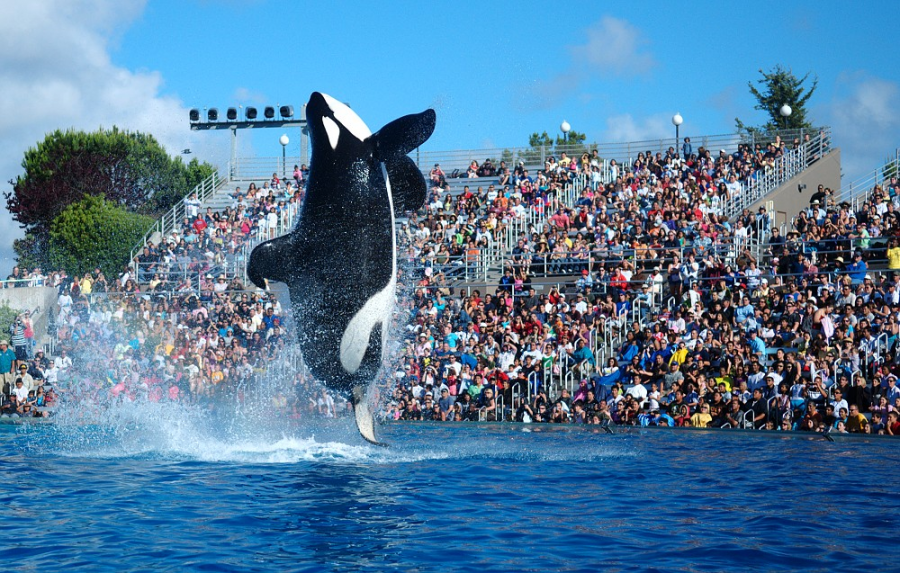That’s What She Said: Putting an end to Sea World in 2019
Leaping through the air, this orca performs for an eager audience at the Seaworld park in San Diego. However, notice the flopped-over dorsal fin, a phenomenon that only occurs when orcas are kept in captivity.
March 26, 2019
Imagine spending your whole life in a bathtub – annoying, right? Now you understand the frustration felt by the animals living at Seaworld theme parks across America. Launched in 1959, Seaworld has made a name for itself as a classic American family-friendly destination. However, the allure of the fantastical whale and dolphin shows began to wear off as people started questioning the behind-the-scenes life of their favorite aquatic stars. At SeaWorld, majestic killer whales are confined to tiny tanks, drugged to relieve the stress of mindlessly swimming in circles, and constantly monitored to prevent dangerous boredom-driven behaviors. Due to the extremely low quality of life experienced by the animals, their frustrations can manifest into aggression toward audiences or trainers.
The documentary Blackfish, released in 2013, exposed the horrors of Seaworld by following a specific orca named Tilikum, who is allegedly responsible for the deaths of three people. Former trainers were interviewed in the movie about their experiences at Seaworld, and many share a similar story: at first they were captivated by the magic of working with such magnificent animals, but soon began to notice the underlying problems in the amusement parks. Their former coworker, Dawn Brancheau, was a Seaworld trainer who was killed at the park in 2010 by Tilikum during a show. The Occupational Safety and Health Administration, commonly referred to as OSHA, took Seaworld to court, claiming that interacting so closely with the orcas frequently placed trainers in imminent danger. After the citation, Seaworld ruled that trainers cannot be in the water with the animals during shows, and there must be a barrier of some kind between them.
Beyond being very dangerous for humans, Seaworld also provides an extremely low quality of life for the animals they keep in captivity. Orcas are one of the world’s most powerful predators and have been documented in the wild diving to depths of 525 feet. However, Seaworld’s orcas are confined to tanks that are only 35 feet deep. Additionally, Seaworld has come under fire for stating in their parks that orcas live longer in captivity, at an average of fourteen years. This has been disputed as there are reports of orcas that have been tracked living up to one hundred years old. People for the Ethical Treatment of Animals, or PETA, is a nonprofit organization that has devoted lots of attention to raising awareness about Seaworld, coining the term “abuse-ment” parks on their site. Senior Maddie Gould is also against SeaWorld theme parks: “I personally think Seaworld is an awful place when it comes to animal treatment. Orca whales can swim up to 140 miles a day in the wild, while at Seaworld they would have to swim 4,280 laps in their tanks to even get close to that amount. That is just cruel.”
You may wonder if there is hope for change. SeaWorld has yet to publicly recognize the atrocities of their actions in their parks in the United States, but Canada has recently passed legislation banning whales and dolphins from being kept in captivity in parks in their country. This new bill, S-203, sets a new precedent for the rights of whales and dolphins that will hopefully prompt America to follow suit.
For now, you can help by boycotting SeaWorld theme parks and spreading the word to end SeaWorld for good.













Dr. Tom Ottinger • Oct 14, 2019 at 9:29 am
Have you ever heard the expression “throwing the baby out with the bathwater?” Perhaps the only thing worse than exposing people to exploitative carnival acts is exposing them to nothing at all.
Most young people (“millenials”)understand and want to see the importance of zoos and aquariums in arousing social consciousness. You cannot further illustrate the impressive scope–and yes, danger–of these animals too much outside of a live environment. A video screen or simulation can be shut off. That deprives people of the tangible reality of seeing these creatures and why they must be protected. Out of sight means it is just another Internet video or article–quickly forgotten in the stream of online distractions. Worse, it can allow others to manipulate the public perceptions if they have no first-hand knowledge of what they are and what they act like.
I do not work for SeaWorld, but even I can acknowledge the good that they have done for research and conservation. If they go, what will fill the gap? Should only the rich and privileged be allowed to witness these natural treasures?